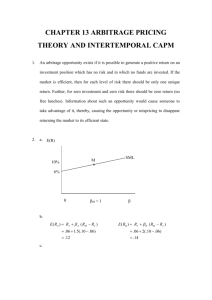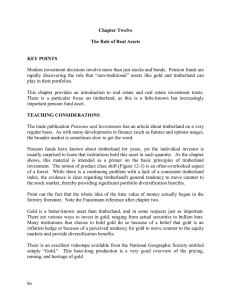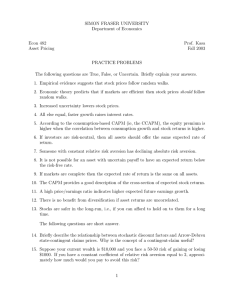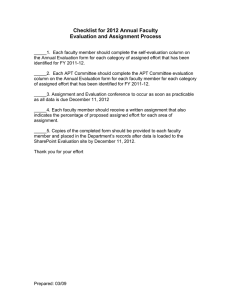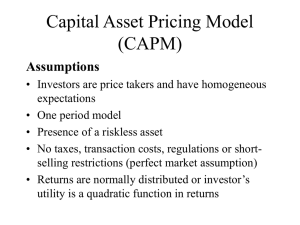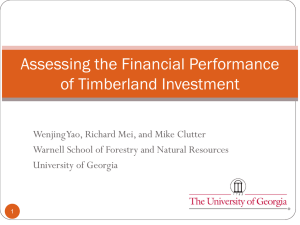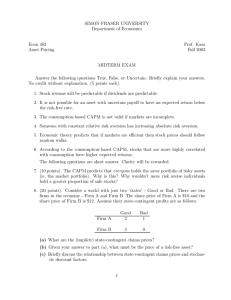American J Agri Economics - 2001 - Sun - Assessing the Financial Performance of Forestry‐Related Investment Vehicles
advertisement
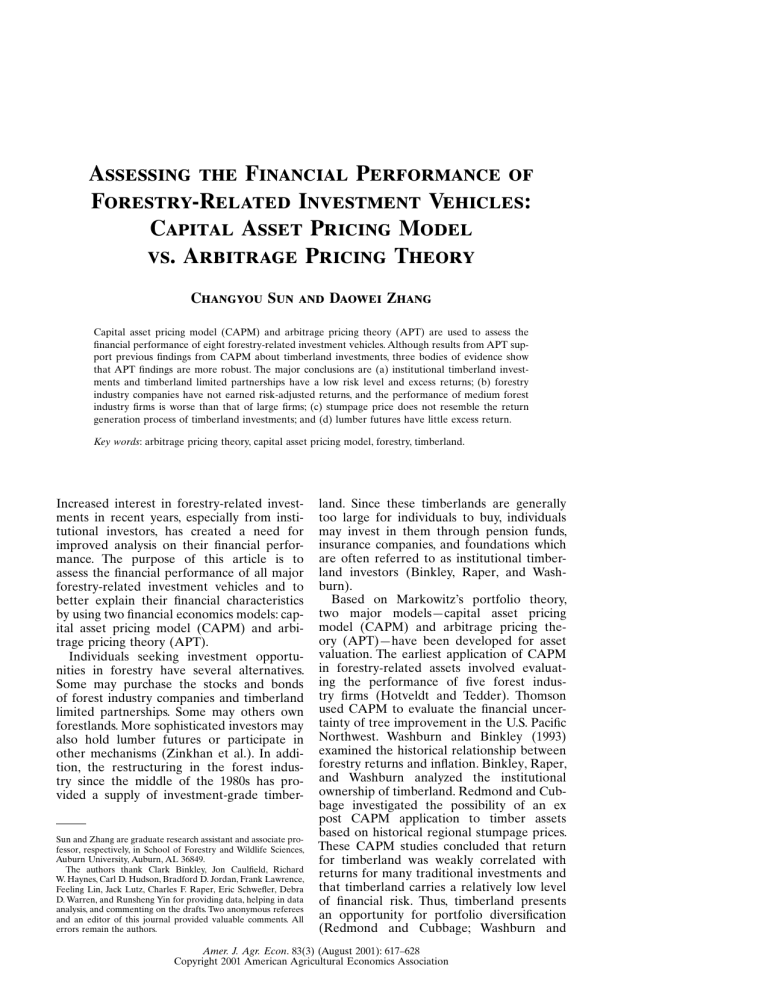
Assessing the Financial Performance of Forestry-Related Investment Vehicles: Capital Asset Pricing Model vs. Arbitrage Pricing Theory Changyou Sun and Daowei Zhang Capital asset pricing model (CAPM) and arbitrage pricing theory (APT) are used to assess the financial performance of eight forestry-related investment vehicles. Although results from APT support previous findings from CAPM about timberland investments, three bodies of evidence show that APT findings are more robust. The major conclusions are (a) institutional timberland investments and timberland limited partnerships have a low risk level and excess returns; (b) forestry industry companies have not earned risk-adjusted returns, and the performance of medium forest industry firms is worse than that of large firms; (c) stumpage price does not resemble the return generation process of timberland investments; and (d) lumber futures have little excess return. Key words: arbitrage pricing theory, capital asset pricing model, forestry, timberland. Increased interest in forestry-related investments in recent years, especially from institutional investors, has created a need for improved analysis on their financial performance. The purpose of this article is to assess the financial performance of all major forestry-related investment vehicles and to better explain their financial characteristics by using two financial economics models: capital asset pricing model (CAPM) and arbitrage pricing theory (APT). Individuals seeking investment opportunities in forestry have several alternatives. Some may purchase the stocks and bonds of forest industry companies and timberland limited partnerships. Some may others own forestlands. More sophisticated investors may also hold lumber futures or participate in other mechanisms (Zinkhan et al.). In addition, the restructuring in the forest industry since the middle of the 1980s has provided a supply of investment-grade timberSun and Zhang are graduate research assistant and associate professor, respectively, in School of Forestry and Wildlife Sciences, Auburn University, Auburn, AL 36849. The authors thank Clark Binkley, Jon Caulfield, Richard W. Haynes, Carl D. Hudson, Bradford D. Jordan, Frank Lawrence, Feeling Lin, Jack Lutz, Charles F. Raper, Eric Schwefler, Debra D. Warren, and Runsheng Yin for providing data, helping in data analysis, and commenting on the drafts. Two anonymous referees and an editor of this journal provided valuable comments. All errors remain the authors. land. Since these timberlands are generally too large for individuals to buy, individuals may invest in them through pension funds, insurance companies, and foundations which are often referred to as institutional timberland investors (Binkley, Raper, and Washburn). Based on Markowitz’s portfolio theory, two major models—capital asset pricing model (CAPM) and arbitrage pricing theory (APT)—have been developed for asset valuation. The earliest application of CAPM in forestry-related assets involved evaluating the performance of five forest industry firms (Hotveldt and Tedder). Thomson used CAPM to evaluate the financial uncertainty of tree improvement in the U.S. Pacific Northwest. Washburn and Binkley (1993) examined the historical relationship between forestry returns and inflation. Binkley, Raper, and Washburn analyzed the institutional ownership of timberland. Redmond and Cubbage investigated the possibility of an ex post CAPM application to timber assets based on historical regional stumpage prices. These CAPM studies concluded that return for timberland was weakly correlated with returns for many traditional investments and that timberland carries a relatively low level of financial risk. Thus, timberland presents an opportunity for portfolio diversification (Redmond and Cubbage; Washburn and Amer. J. Agr. Econ. 83(3) (August 2001): 617–628 Copyright 2001 American Agricultural Economics Association August 2001 Binkley 1993). However, problems with the composition of the true market portfolio, the low explanatory power of the model, and the low accuracy of prediction have been reported in forestry literature as well as in the analysis of other financial assets (Arthur, Carter, and Abrzadeh; Washburn and Binkley 1989). APT is a theory concerned with deriving the required rates of returns on risky assets based on the asset’s systematic relationship to several risk factors. In contrast to the singlefactor in CAPM, APT allows multiple factors to influence asset returns. Thus, APT can be viewed as an extension of the single-factor market model (CAPM). Although more intuitive, APT makes no statements about the size or the sign of the risk premium for each factor. Therefore, how to use analytic models to select the factors and interpret them is critical in applying APT. The statistical factor model, originally proposed by Gehr and subsequently extended by Roll and Ross, has been most widely used in APT studies. Since 1980, numerous empirical studies have been conducted to test whether APT does a better job in explaining asset returns than does CAPM. Roll and Ross conducted the first empirical investigation of APT using individual equity data. Arthur, Carter, and Abrzadeh used APT to analyze the relationship between risk and returns for agricultural assets from 1976 to 1984. The APT results are generally more robust than CAPM. However, no APT study could be found in forestry-related investment, and studies on timberland investment have not been put in contrast with other forestry investment vehicles. This study fills in the gaps by empirically investigating the financial characteristics of all major forest-related investment vehicles and by comparing the results from both CAPM and APT. Although this article is a direct extension of other studies comparing CAPM and APT (e.g., Arthur, Carter, and Abrzadeh), it expands the literature on forestry investments by analyzing all major forestry investment alternatives except much diverse and fragmented non-industrial private forestland ownership (due to data constraint). The main findings of this paper generally confirm previous CAPM results and should be interesting to those who are dealing with timberland investment as well as to a wider audience of financial managers who are interested in alternative asset classes. The next section presents methodology, the third Amer. J. Agr. Econ. section describes data, the fourth section provides data analysis and results, and the final section draws some conclusions. Methodology Capital Asset Pricing Model Developed by Sharpe and Lintner in the mid-1960s, CAPM states that the required or expected return on an investment should be equal to the rate earned on a riskless investment plus a premium for the assumption of market risk (1) Ri = Rf + βi (Rm − Rf ) where Ri is the required rate of return on investment i, Rf is the risk-free rate of return (measured by the yield on US T-bills), βi is investment i’s risk premium, commonly know as beta, and Rm is the market’s expected rate of return (with a market indicator series such as the S&P 500 as the proxy for the market). Jenson proved that CAPM is consistent with the regression equation or excess return form (2) Ri − Rf = αi + βi (Rm − Rf ) + µi The intercept αi for CAPM regression signifies the valuation of an asset due to the factors other than the overall market. A positive alpha indicates that the asset has an expected return that is greater than the market required in the risk class (as measured by beta) and thus indicates a superior riskadjusted return. βi is an indicator of the asset’s market risk. If the beta value is greater (less) than 1, the asset moves more (less) than a corresponding move in the market. Thus, such asset is said to be more (less) risky than the market.1 Arbitrage Pricing Theory APT was developed by Ross and enhanced by others. APT is based on the law of one 1 We also conducted a CAPM model with inflation, which is termed as capital asset pricing model under uncertain inflation (Brueggeman, Chen and Thibodeau). The results were not much different from these reported for CAPM. The model and results are available from the authors. 14678276, 2001, 3, Downloaded from https://onlinelibrary.wiley.com/doi/10.1111/0002-9092.00182 by University Of Leicester Library, Wiley Online Library on [06/12/2023]. See the Terms and Conditions (https://onlinelibrary.wiley.com/terms-and-conditions) on Wiley Online Library for rules of use; OA articles are governed by the applicable Creative Commons License 618 Financial Performance of Forestry-Related Investments price, which states that two otherwise identical assets cannot sell at different prices. It assumes that asset returns are linearly related to a set of indexes, each representing a factor that influences the return of an asset. Asset returns are randomly generated according to an n-factor model (3) Ri = E(Ri ) + βi1 δ1 + βi2 δ2 + · · · + βin δn + ei where Ri is the actual (random) rate of return on asset i in any given period, E(Ri ) is the expected return on asset i, δn is a common factor with a zero mean that influences the returns on all assets, βin is sensitivity of asset i to factor n, and ei is random error term, unique to asset i. The sensitivity measure βin in APT has similar interpretations to βi in CAPM. They are measures of the relative sensitivity of an asset’s return to a particular risk factor. Considering the risk premiums in both cases, the CAPM relationship would be the same as would be provided by APT if there were only one pervasive factor influencing returns. In conjunction with the assumption of zero arbitrage profits, the above multiple factor model leads to the APT pricing equation: (4) E(Ri ) = λ0 + βi1 λ1 + βi2 λ2 + · · · + βin λn + ηi where the λn are interpreted as risk premium (If there is a risk-free rate λf , then λ0 = λf ). Among various techniques in empirical application of APT, the maximum likelihood factor analysis (MLFA) is the most frequently used. MLFA has desirable asymptotic properties and can be used to test hypotheses about the number of common factors. We use MLFA to extract the factor scores, calculate the risk premium for each common factor, and evaluate the financial performance of the forestry-related assets. Consensus has not been reached on two issues in the empirical application of APT. First, various numbers of factors have been recommended. Roll and Ross concluded that no more than four or five factors are relevant. Although some studies have identified or prespecified as many as ten factors (Robin and Shukla), most empirical studies suggested that only three to five factors have influenced asset returns and are priced in the market (Chen; Chen, Roll, and Ross; Bubnys). Second, sample size and formation does matter, 619 and a different formation may yield different results (Livingston; Dhrymes, Friend, and Gultekin). Nevertheless, sample size and formation vary widely in previous studies. Two approaches have emerged. One is to use the returns of a sample of firms to extract factor scores (Roll and Ross; Collins) and then used these factors to estimate the required returns for other firms. Since companies to be evaluated are not included in the statistical factor estimation process, the validity of using the factors generated to evaluate them may be questionable. The second approach uses small, relevant samples, including the assets to be evaluated, to extract factor scores. For example, Arthur, Carter, and Abrzadeh used fourteen farm assets and nine non-farm assets together to extract factor scores and then evaluated the performance of the fourteen farm assets. This approach showed promising results. Although Bower, Bower and Logue tried both ways and found similar results, no consensus has been reached on how to select and form the sample to extract factor scores in APT application. The second approach is used in this study. There are two other types of factor analysis. Macroeconomic factor models use observable economic time series, such as inflation, interest rates and GDP, as measures of the pervasive shocks to security returns. Fundamental factor models use the returns to portfolios associated with observed security attributes such as dividend yield, book-to-market ratio, and industry identifiers (Connor). In contrast, the statistical factor model used in this study derives the pervasive factors from factor analysis of the panel data set of security returns alone. All three models are used to find the factors influencing the arbitrage opportunities among assets. The factors in the first two models are observable, while those in the third model are not. Although it is interesting to compare the results of these three models, conducting other types of factor analysis requires completely different data sets and methodologies and is beyond the scope of this paper. Data Eighteen investment portfolios or price indexes were selected for this study, eight of which are forest-related, and the rest serve as approximate control and comparison groups for return generation process of all assets. 14678276, 2001, 3, Downloaded from https://onlinelibrary.wiley.com/doi/10.1111/0002-9092.00182 by University Of Leicester Library, Wiley Online Library on [06/12/2023]. See the Terms and Conditions (https://onlinelibrary.wiley.com/terms-and-conditions) on Wiley Online Library for rules of use; OA articles are governed by the applicable Creative Commons License Sun and Zhang August 2001 All data have quarterly returns from 1986 to 1997 with forty-eight observations except the returns for NCREIF timberland index, which have only forty-four observations (1987–97). The eight forestry-related assets are Timberland Performance Index (TPI), NCREIF Timberland Index (NCREIF-T), Timberland Limited Partnership Portfolio (TLP), Large Forest Industry Company Portfolio (L-FICP), Medium Forest Industry Company Portfolio (M-FICP), Southern Stumpage Price Average (SSPA), Pacific Northwest Stumpage Price Average (PNSPA), and Lumber Futures (LUMBER). The TPI and NCREIF-T are chosen to represent institutional timberland investments. TPI is an indicator based on quarterly total returns from different timberland funds managed by several timberland investment management organizations (Caulfield). The basic data for TPI appear in Real Estate Profiles, published quarterly by Evaluation Associates, Inc. (Caulfield). NCREIF-T is published quarterly by the National Council of Real Estate Investment Fiduciaries (NCREIF 1998a). It currently covers more than 75% of all institutionally managed timberlands (Binkley). TLP includes four publicly traded timberland limited partnership companies, which were spin-offs from several forest products firms in the 1980s.2 They own and manage timberland only, and all have timber supply agreements with their general partners, usually the forest products firms that created them. TLP represents an asset for investors who want to own some timberland, but do not want to own forest products processing facilities. The financial characteristics of this investment option serve as a good contrast to those of forest industry firms, which own both timberland and processing facilities. L-FICP consists of fifteen forest industry firms that are listed in Fortune 500 in 1997. M-FICP is made up of fifteen mediumsize primary timber processing companies which are in SIC 24 (wood products) or SIC 26 (paper and allied industries) and that were traded continuously between 1986 and 1997.3 Quarterly returns for these three portfolios are obtained from the Center for Research in Stock Price (CRSP) database 2 The firms are International Paper TLP, Rayonier TLP, Plum Creek TLP, and Pope Resources LP. 3 A list of these firms in L-FICP and M-FICP can be obtained from the authors. Amer. J. Agr. Econ. by the University of Chicago. Market value weighting is used to form each portfolio.4 SSPA is the average of southern pine pulpwood and sawtimber stumpage (Timber Mart-South). PNSPA is the average value of timber harvested on the National Forests of the Pacific Northwest (Haynes and Warren).5 The primary reason for including them in this study is to use them (like stock prices) to generate the statistical factors influencing all major forestry-related investment vehicles. In addition, some researchers (e.g., Redmond and Cubbage; Conroy and Miles) assessed timberland performance based on historical stumpage price alone. Since stumpage prices are merely one of several major sources of returns of timberland investment, they may not be used alone as an indicator of returns for forestlands of many non-industrial private forest landowners. The results of this study support this statement. The last forest-related alternative is lumber futures (Spruce-Pine-Fir 2 × 4), which are traded on Chicago Mercantile Exchange (Bridge CRB). The return series is formed from the contracts whose expirations are closest to the quarters and hence is almost equivalent to the spot price of lumber. The price of lumber futures reflects the situation in the solid wood products market. The ninth to eighteenth portfolios are only used in APT to generate multiple factors.6 4 Equal weighting has been tried, and the results are similar to these reported in this article. 5 Several stumpage prices are reported in the Pacific Northwest (Haynes and Warren). The most widely used stumpage prices are the bid prices for USDA Forest Service timber sales. They are generally cited as “sold” or “bid” prices. An alternative measure of current stumpage prices is the average prices of stumpage harvested, or the so-called “cut” prices. The major distinction between cut and sold prices is that the cut prices represent the current price of timber harvested or the worth of the timber in the marketplace and the sold prices represent the value (current expectation of future prices) of timber meant for future harvest. Considering the strong forward-looking bias with sold prices in the Pacific Northwest, which is not an issue in the stumpage price data in the South, the cut prices are used for the Pacific Northwest in this study. 6 Wood products (not paper) are primarily used in the housing industry. It is widely recognized that the housing cycle runs a little different from the main business cycle. A good measure of housing cycle is housing starts. However, one cannot easily convert housing starts into a return series and directly compare it with other series used in this study because housing starts is a volume variable (not an asset) and cannot have the interpretation of arbitrage. Alternatively, we tried to run a simple OLS regression and to see if the variance in housing starts can be explained by the 18 series that we used in this article to generate multiple factors. The results showed that, to some extent, the space spanned by the linear combination of the existing assets might include housing starts or a transformation of it (R2 = 049, adjusted R2 = 020). Therefore, future research on macroeconomic factor analysis of forestry-related investments ought to explore the influence of changes in housing starts, in addition to 14678276, 2001, 3, Downloaded from https://onlinelibrary.wiley.com/doi/10.1111/0002-9092.00182 by University Of Leicester Library, Wiley Online Library on [06/12/2023]. See the Terms and Conditions (https://onlinelibrary.wiley.com/terms-and-conditions) on Wiley Online Library for rules of use; OA articles are governed by the applicable Creative Commons License 620 Financial Performance of Forestry-Related Investments The ninth “portfolio” is the NCREIF Farmland Index (NCREIF-F) (NCREIF 1998b). Since timberland and farmland are interchangeable in many regions of the U.S., their return generation process may be influenced by similar factors. The tenth and eleventh “portfolios” are the representatives of stock market indices, reflecting returns of major financial assets. The Russell 2000 (RUSSELL) stands for the small stocks, and S&P500 (SP500) is a composite indicator of the broad market. Dividends are reinvested in calculating both market returns. The twelfth “portfolio” is the long-term government bond (GBOND), a parameter of the bond market (Ibbotson Associates). The thirteenth to fifteenth “portfolios” are quarterly returns of three currency exchange rates: Canadian Dollar (CANADA), Deutsche Mark (MARK), and Japanese Yen (YEN) versus US Dollar, respectively (Federal Reserve Bank of Chicago). They are included not only because the foreign exchange market is a large and efficient financial market, but also because forest products trade among U.S. and Japan, Germany, and Canada is significant. Japan and Germany are the two largest U.S. forest products export markets, and Canada is the largest exporter of forest products to the U.S. and the largest competitor of U.S. forest products in Japan and Germany. The last three assets are three metals: gold (GOLD), steel (STEEL), and aluminum (ALUM) (Bridge CRB). Gold is chosen to represent precious metals, which may have an impact on the timber market. Steel and aluminum are selected because they are substitutes for wood products. Finally, the U.S. Treasury bill rates used in the application of CAPM are from Ibbotson Associates. Data Analysis and Results CAPM Equation (2) was applied to the eight forestry-related assets, and the results were presented in table 1. The alpha coefficients for two timberland indexes, TPI and other macroeconomic variables, such as the unexpected inflation rate, the change in expected inflation, the unexpected change in term structure, the unexpected change in risk premium, and the unanticipated change in growth rate of industrial production (Chen, Roll and Ross). The authors thank an anonymous referee for suggesting this analysis. 621 NCREIF-T, are significantly different from zero at the 10% level. There are no significant excess returns for other six forestry-related assets. The betas for the large forest industry company portfolio (1.04) and the medium forest industry company portfolio (0.94) are close to one and significant from zero at the 10% level. The beta for the timberland limited partnership portfolio is 0.52 and also significant from zero at the 10% level. These results indicate that timberland alone has a lower risk level than the combining of timberland and timber processing facilities (i.e., forest products firms). The betas for other five assets are not significant. The R2 of the regressions on large and medium forest industry company portfolios and timberland limited partnerships are 0.52, 0.51, 0.15, respectively. This is consistent with the correlation coefficients between those three assets and the market portfolio proxy S&P 500, which are 0.73, 0.70, and 0.41, respectively. However, the R2 s are just around zero for the other five assets, which means that CAPM does not explain the return variation of those assets well. The low R2 for the NCREIF-T may partly be caused by the quarterly appraisal methods used in generating the index (Binkley). APT The application of APT to forestry-related investments is more complicated than that of CAPM. The analysis proceeds in five steps. Step 1. Calculate factor loading for each asset. For the eighteen selected assets, a maximum likelihood factor analysis is performed on their time series returns. Due to the data constraint from NCREIF-T, only forty-four quarterly returns (1987–97) are used in all following APT analysis. This procedure estimates the number of factors and the matrix of factor loading for each asset. Using the different factor selection criteria (SAS Institute) results in three to seven factors. In light of previous studies, five factors are used in this study. In computing the factor-loading matrix, many previous researches used some kind of rotation method like orthogonal (i.e., varimax) rotation. In theory, no factor-loading matrix is better than others in explaining the correlation of the raw data with orthogonal rotation. Although the impact of any given factor will change, the total explanatory power is unaffected by rotation. In this study, 14678276, 2001, 3, Downloaded from https://onlinelibrary.wiley.com/doi/10.1111/0002-9092.00182 by University Of Leicester Library, Wiley Online Library on [06/12/2023]. See the Terms and Conditions (https://onlinelibrary.wiley.com/terms-and-conditions) on Wiley Online Library for rules of use; OA articles are governed by the applicable Creative Commons License Sun and Zhang August 2001 Table 1. Amer. J. Agr. Econ. Estimated Results with CAPM α Asset t-ratio Coefficient t-ratio R2 R 0018∗ 0042∗ 0020 309 530 145 007 −005 052∗ 085 −050 280 002 001 015 −001 −002 013 −0003 −0007 −026 −064 104∗ 094∗ 709 695 052 051 051 050 0009 0008 0004 088 036 015 −045 071 046 000 001 000 −002 −001 −002 SSPA PNSPA LUMBER ∗ Significant 2 Coefficient TPI NCREIF-T TLP L-FICP M-FICP β −006 021 014 at the 10% level. the rotated factor-loading matrix is adopted (table 2). An advantage of rotating the factor loading is that it reveals how similar assets load on similar factors. Because of the orthogonal rotation, most assets load significantly to only one or two factors, reducing the factorial complexity. The large and medium forest industry companies (L-FICP and M-FICP) and stock market indexes (RUSSELL and SP500), for example, show the greatest sensitivity to Factor 1. This means that they are “similar” assets. Except that Factor 4 explains most variation for TFP and Factor 5 for TPI, the other 16 indexes are loaded on one or two of the first three factors by similar asset grouping. Therefore, while factors are generally understood to describe common economic movements behind various investment vehicles, the various asset groupings used in this study seem to represent those movements well.7 Step 2. Calculate factor scores for every quarter. Bartlett’s procedure is used to esti7 It is tempting to name the five factors in a way such that they reflect the underlying economic movements for different asset groups. Theoretically, in the absence of estimation error and with no limits on data availability, the maximum likelihood analysis should reach the same final result as the macroeconomic factor model or fundamental factor model (Connor). In reality, naming the factors with certainty is very difficult with this kind of explanatory factor analysis. Table 2. Rotated Factor Loading and Residual Value through Maximum Likelihood Factor Analysis Asset TPI NCREIF-T TLP L-FICP M-FICP SSPA PNSPA LUMBER NCREIF-F RUSSELL SP500 GBOND CANADA MARK YEN GOLD STEEL ALUM Factor 1 Factor 2 Factor 3 Factor 4 Factor 5 Residual 6 −16 46 90 90 −8 17 13 −12 85 88 12 −43 20 12 −13 8 0 7 21 10 −11 −9 −29 −25 −3 52 35 27 −4 32 73 59 −56 2 −11 2 6 11 22 34 15 28 31 −12 1 −20 −40 −19 63 18 18 25 23 −5 −1 62 10 11 −2 2 2 1 11 10 0 −4 7 4 −3 2 0 55 1 −13 4 5 −2 −1 1 3 7 6 0 0 6 5 −4 1 0 06909 09249 03648 01235 00602 08868 08315 08878 07011 01448 00974 08244 06766 00113 06030 06291 09316 09373 Note: The values for factor loading are multiplied by 100. 14678276, 2001, 3, Downloaded from https://onlinelibrary.wiley.com/doi/10.1111/0002-9092.00182 by University Of Leicester Library, Wiley Online Library on [06/12/2023]. See the Terms and Conditions (https://onlinelibrary.wiley.com/terms-and-conditions) on Wiley Online Library for rules of use; OA articles are governed by the applicable Creative Commons License 622 Financial Performance of Forestry-Related Investments Table 3. Asset TPI NCREIF-T TLP L-FICP M-FICP SSPA PNSPA LUMBER NCREIF-F RUSSELL SP500 GBOND CANADA MARK YEN GOLD STEEL ALUM ∗ Significant Assets’ Sensitivity to Each Factor Beta 2 Beta 3 Beta 4 Beta 5 R2 R 00522 −00616 04534∗ 09870∗ 09027∗ −01501 −00226 00359 −00086 09991∗ 07250∗ 00885 −00873∗ 01930∗ 01594∗ −01787∗ −01037 −01797 −00427 01185 −00137 −02517∗ −02297∗ −03466∗ −06913∗ −02839 01677∗ 03250∗ 01394∗ −00876 00861∗ 06177∗ 05215∗ −03935∗ −00680 −01091 00506 00642 01414∗ 02475∗ 04129∗ 00528 03324 06040∗ 00010 00252 −02035∗ −02774∗ −00268 06661∗ 03085∗ 00200 01969 02470 −00675∗ −01438∗ 05964∗ 00233 01123∗ 00641 00233 −00505 00229 01898∗ 00194 −00297 00244 00472∗ 00769 −01240∗ −00161 00215 05303∗ 02389∗ −01426∗ 00030 00962∗ 02027 −02555 03898 00841 −00052 00264 01729 00526 00504 01576 −01820∗ −03248 −06383∗ 078 030 096 091 096 031 025 015 031 084 089 027 038 092 047 051 009 016 075 021 095 090 095 022 015 003 022 082 088 018 029 091 040 044 −003 005 at the 10% level. Ft = (B D −1 B)−1 B D −1 Rt where D is the 18 × 18 diagonal matrix of residual variances produced by the factor analysis in step 1 (see the last column in table 2), and Rt is the 18 × 1 vector of returns on the 18 assets in quarter t.8 Step 3. Calculate sensitivity coefficients for each asset. To obtain the sensitivity coefficients to systematic factors for each asset, the time series returns are regressed on these quarterly factor scores from the previous step as follows (table 3) (6) Rit = αit + βij Fjt + · · · + βi5 F5t + φit where Rit is the realized return on asset i in quarter t i = 1 18 t = 1 44, αit is the intercept for asset i, βij is the factor beta or sensitivity coefficients for asset i on factor j, j = 1 5, Fjt is the value of factor score j in quarter t j = 1 5 and φit is the residual error for asset i in quarter t. Step 4. Calculate risk premium associated with each factor. The risk premium associated with each factor is calculated as the average value from cross-sectional regressions of quarterly asset returns on asset sensitivity coefficients. Forty-four cross-sectional regressions of the asset returns on the factor betas estimated in the previous step are estimated as follows (7) The factor scores Ft calculated in this fashion are identical to the results from estimating a cross-sectional generalized least squares regression of the asset returns Rt against the factor loading B weighted by residual variances D. Rit = λ0t + λjt βij + · · · + λ5t βi5 eit where Rit is the realized return on asset i in quarter t i = 1 18 t = 1 44, λ0t is the intercept in quarter t, λjt is the estimated risk premium for factor j in quarter t j = 1 5, βij is the factor beta or sensitivity coefficients for asset i on factor j j = 1 5, eit is the residual error for asset i in quarter t. The average values of lambda parameters over the above regressions are used as risk premiums for each factor in the APT model. The mean values are the following (8) 8 2 Beta 1 mate the factor scores for each quarter. The estimates of individual asset factor loading from the previous step are used to explain the cross-sectional variation of individual estimated returns. This estimates the time series factor scores for each quarter. If B is taken to be the 18 × 5 factor loading matrix from the previous step augmented with a column vector of ones, then the factor scores in quarter t, Ft , are calculated as follows (5) 623 λ0 = 00236 λ1 = 00186 λ2 = −00144 λ3 = −00191 λ4 = −00210 λ5 = 00138 14678276, 2001, 3, Downloaded from https://onlinelibrary.wiley.com/doi/10.1111/0002-9092.00182 by University Of Leicester Library, Wiley Online Library on [06/12/2023]. See the Terms and Conditions (https://onlinelibrary.wiley.com/terms-and-conditions) on Wiley Online Library for rules of use; OA articles are governed by the applicable Creative Commons License Sun and Zhang August 2001 Amer. J. Agr. Econ. Table 4. Annual Historical and Required Returns for Forestry-Related Assets: APT vs. CAPM Asset TPI NCREIF-T TLP L-FICP M-FICP SSPA PNSPA LUMBER Required Annual Rate of Return with Excess Return Percentage with Historical Annual Rate of Return CAPM APT CAPM APT I II III (I-II)/II (I-III)/III 612 473 1135 1748 1634 465 781 702 1206 793 1606 1657 1582 1158 950 846 133 352 63 −16 −21 94 11 3 18 170 15 −11 −18 −22 −9 −14 ∗ 1428 2141 1850 1477 1291 903 867 726 Label∗∗ A A A B B C C C ∗ All values are percentage. performance is better than the requirement from both models. B—Historical performance is worse than the requirement from both models. C—Two models produce different results. ∗∗ A—Historical Step 5. Calculate the required returns. With the sensitivity coefficients for each asset from step 3 and risk premiums for each factor from step 4, the required returns E(Ri ) for each forestry-related asset can be calculated using equation (4) (See table 4) (9) E(Ri ) = 00236 + 00186βi1 − 00144βi2 − 00191βi3 − 00210βi4 + 00138βi5 Comparison of CAPM and APT For comparison, the required returns for forestry-related assets associated with the estimated risk level under CAPM are computed using equation (1). Several results have emerged by comparing these required returns from both models (table 4). First, timberland investments have low required rates of returns. This is evident in that both TPI and NCREIF-T have a lower required return than those of forest products firms. Moreover, although the required return of TLP is comparable to those of forest products firms under APT, it has a lower required return under CAPM and its historical return is higher than its own required return. In all three timberland indexes, the historical returns are higher than the required returns (labeled as “A” in table 4), especially for NCREIF-T. The good performance of timberland investment is consistent with several previous studies (Washburn and Binkley 1993; Binkley, Raper and Washburn), and the difference between NCREIF-T and TPI can be attributed to the fact that these indexes do not cover the same timberlands. On the other hand, the difference in the required rates of return between institutional timberland investments (TPI and NCREIF-T) and timberland limited partnerships (TLP) may be attributed to the existence of a timber supply agreement between timberland limited partnerships and the forest products company which created them. Second, both large and medium forestry industry companies (L-FICP and M-FICP; labeled as “B” in table 4) seem unable to earn enough risk-adjusted returns, although the difference between historical returns and the required returns is not statistically significant at a reasonable level. Furthermore, the performance of medium forestry industry firms is slightly worse than that of the large forestry industry companies. Since both medium and large forest products firms have more pulp and paper companies (Standard Industrial Code or SIC 26) than wood products companies (SIC 24), this difference may reflect more on the economy of scale than on the group company composition and may explain the heavy merging activities observed in recent years in the forest products industry. Third, as expected, the return on SSPA or PNSPA is not as good as the two timberland indexes. This suggests that stumpage price alone does not resemble the return generation process of timberland investments and that using a stumpage price index to study the financial performance of timberland investments is inadequate. 14678276, 2001, 3, Downloaded from https://onlinelibrary.wiley.com/doi/10.1111/0002-9092.00182 by University Of Leicester Library, Wiley Online Library on [06/12/2023]. See the Terms and Conditions (https://onlinelibrary.wiley.com/terms-and-conditions) on Wiley Online Library for rules of use; OA articles are governed by the applicable Creative Commons License 624 Financial Performance of Forestry-Related Investments The two models have generated some different results as well. APT has a higher requirement than CAPM since six out of the eight required returns are higher with APT than with CAPM. The exceptions are L-FICP and M-FICP. Specifically, the positive excess return with TPI, NCREIF-T, and TLP are smaller under APT than under CAPM. For SSPA, PNSPA, and LUMBER, CAPM concludes that there are positive excess returns, but APT shows negative excess returns (labeled as “C” in table 4). Further tests reported in table 5 show that the differences between the historical returns of timberland (TPI, NCREIF-T, and TLP) and the required returns under CAPM are statistically significant at or around the 10% level, and so is the difference between the historical return of NCREIF-T and its required return under APT. The required returns for two of the timberland indexes (TPI and NCREIF-T) are statistically different under CAPM and APT, while the other one (TLP) is marginally significant (around the 20% level). In the light of these different results from these models, we have conducted three comparisons to find out which one of the two competing models provides a better explanation of the relationship between risk and returns. They all support the fact that APT findings are more robust than CAPM findings. First, APT can explain a larger share of return variation among the securities than CAPM. For CAPM, only three of the eight forestry-related assets have betas significant at the 10% level (table 1). In contrast, with APT, every asset has at least one reaction coefficient significant at the 10% level, and five have at least two reaction coefficients significant. In addition, the adjusted R2 , which considers the effect brought by additional explanatory variables, has been greatly improved for seven assets and the average value is 0.52 for APT and 0.14 for CAPM. Only for one asset, LUMBER, the adjusted R2 values from both models are around zero. The high adjusted R2 for APT could be directly attributed to the fact that it includes more variables than CAPM. This comparison of R2 would not be valid if the purpose is to choose one of several APT models. Second, following Chen, a test described in Davidson and Mackinnon for discriminating between competing models was conducted. In each of forty-four quarters, the actual returns on the eighteen assets are regressed cross-sectionally against the predicted returns as follows: (10) Rit = θt Rapt t + (1 − θt )Rcapm t + uit where Rit is the actual returns to the 18 assets in quarter t; Rapt t and Rcapm t are the required returns for each asset in quarter t from each model, respectively; θt is the regression coefficient; and uit is the error term. θt is expected to be close to one if APT is a better model. We found that the mean Table 5. Test of Significance Between Historical and Required Rates of Return, Between CAPM and APT as well as Between Large and Medium Forest Products Firms Historical-CAPM TPI NCREIF-T TLP L-FICP M-FICP SSPA PNWSP LUMBER Historical Returns CAPM Required Returns APT Required Returns ∗ The 625 Historical-APT CAPM-APT P value for t-test between returns (%)∗ 006 2968 452 000 001 538 1075 3744 2081 3667 4180 4592 3183 3666 4787 1227 3015 178 4596 4678 3786 4890 4568 4051 P value for t-test between L-FICP and M-FICP (%) 4124 4248 4659 null hypothesis is that the two series compared are the same statistically (two tails). 14678276, 2001, 3, Downloaded from https://onlinelibrary.wiley.com/doi/10.1111/0002-9092.00182 by University Of Leicester Library, Wiley Online Library on [06/12/2023]. See the Terms and Conditions (https://onlinelibrary.wiley.com/terms-and-conditions) on Wiley Online Library for rules of use; OA articles are governed by the applicable Creative Commons License Sun and Zhang August 2001 of θt is 0.88, and forty of the forty-four coefficients are significant at the 5% level. Third, following Bower, Bower, and Logue, the quality of the forecast was assessed by using an approach suggested by Theil. The Theil measure, U 2 , assesses whether the two models are an improvement over a naı̈ve model and, if both are, determines which of the two represents a greater improvement. Theil’s U 2 is the sum of the squared forecasting errors from a particular model divided by the sum of the squared forecasting errors from a naı̈ve forecasting rule 44 models 2 ) t=1 (Ri t − Ri t (11) Ui2 = 44 2 t=1 (Ri t − Ri ) (i = 1 2 18) where Ri t is the historical return for asset i in quarter t, Rmodels is the forecast returns 1 t for asset i in quarter t by model CAPM or APT, and Ri is the quarterly average historical returns for asset i during the 44 quarters. Here, the naı̈ve forecasting rule uses the average return over the 44 quarters as the predicted return in each quarter. The smaller the ratio, the better the model forecast is relative to the naı̈ve forecast. A ratio with a value greater than one would indicate the inappropriateness of the pricing model being considered. For CAPM, 7 out of the 18 U 2 values for the 18 assets or indexes are less than one, and the average value is 0.93. For APT, 14 of 18 values are less than one, and the average is 0.60. Therefore, APT outperforms CAPM as a forecasting model of required or expected return. Discussion and Conclusions This study evaluates the financial performance of eight forestry-related assets and indexes using capital asset pricing model and arbitrage pricing theory. Under the framework of CAPM, timberland investments have excess returns. Timberland alone has a lower level of risk than forest industry companies which combine timberland and timber processing facilities. APT produces some similar results, although six out of the eight required returns are higher with APT than with CAPM, implying that APT has a higher requirement than CAPM in most cases. Three bodies of evidence support that APT findings are more robust than the findings from CAPM. Amer. J. Agr. Econ. The historical returns of institutional timberland investments and, to a lesser extent, timberland limited partnerships in the past eleven years (1987–97) are substantially higher than the required returns. This superior performance of these kinds of assets suggests that they could be good investment vehicles for some investors. However, the widely observed success of the institutional timberland investments might be related to timber price hikes induced by the environmental regulations and the lack of liquidity in timberland markets. Future performance of timberland may well change, depending on the interaction of various factors in the market. Forest industry companies do not earn risk-adjusted returns, and the performance of medium forestry industry firms is slightly worse than that of the large forestry industry companies. The poor performance of the forest products companies and the good performance of timberland investments may have caused many forest industry firms to restructure through merger, acquisition, and sale of their timberlands in recent years. The performance of two stumpage price indexes is not as good as that of timberland investments. This implies that they do not resemble the return generation process of timberland investments as they do not include biological growth, land appreciation and other non-market factors. Finally, lumber futures have barely earned the required return. These results imply that timberland investment will continue to be a growing business in the future (Donegan). It has some good characteristics of an investment asset that investors are looking for, such as low risk, high risk-adjusted return, and low level of correlation with other financial assets. It has performed better than most other forestry investment vehicles. Also, separating timberland from timber processing facilities may enhance investment return. Nevertheless, the results of this study need to be interpreted with caution. First, due to data constraints, only 11 years’ data are used in this study (NCREI-T started the third quarter of 1996 and only four timberland limited partnerships were publicly traded during the study period). In addition, the anomaly of the Heywood Case—some unique factor has negative variance—occurs in the maximum likelihood factor analysis. This might suggest that a larger data set would provide more 14678276, 2001, 3, Downloaded from https://onlinelibrary.wiley.com/doi/10.1111/0002-9092.00182 by University Of Leicester Library, Wiley Online Library on [06/12/2023]. See the Terms and Conditions (https://onlinelibrary.wiley.com/terms-and-conditions) on Wiley Online Library for rules of use; OA articles are governed by the applicable Creative Commons License 626 Financial Performance of Forestry-Related Investments stable estimates for the factor scores. Experience shows that MLFA is very prone to this problem with such a small sample. Other causes may include bad prior communality estimates and too many or too few common factors (SAS Institute). Further research could be directed into improving the data by including more investment vehicles or by covering longer periods of time. Other factor analysis techniques such as principal component factor analysis, other APT factor models such as the macroeconomic factor model, or other asset pricing theory could be used as well. [Received October 1999; accepted July 2000.] References Arthur, L.M., C. Carter, and F. Abizadeh. “Arbitrage Pricing, Capital Asset Pricing, and Agricultural Assets.” Amer. J. Agr. Econ. 70(May 1988):359–65. Bartlett, M.S. “The Statistical Conception of Method Factors.” Brit. J. Psych. 28(1937): 97–104. Binkley, C.S. The Russell-NCREIF Timberland Index: A Review. Faculty of Forestry, University of British Columbia. Vancouver, Canada. 1994. Binkley, C.S., C. Raper, and C.L. Washburn. “Institutional Ownership of U.S. Timberland: History, Rationale, and Implications for Forest Management.” J. Forest. 94 (September 1996):21–8. Bower, D.H., R.S. Bower, and D.E. Logue. “Arbitrage Pricing Theory and Utility Stock Returns.” J. Finance 39(September 1984): 1041–54. Bridge CRB. Bridge CRB Historical Data Guide. 1998. Brueggeman, E.B., A.H. Chen, and T. Thibodeau. “Real Estate Investment Funds: Performance and Portfolio Considerations.” Amer. Real Estate Urban Econ. Assoc. J. 12(1984):333–54. Bubnys, E. “Simulating and Forecasting Utility Stock Returns: Arbitrage Pricing Theory vs. Capital Asset Pricing Model.” Finan. Rev. 25(January 1990):1–23. Caulfield, J.P. “Assessing Timberland Investment Performance.” Real Estate Rev. 24(January 1994):76–81. Chen, N.F. “Some Empirical Tests of the Theory of Arbitrage Pricing.” J. Finance 38(1983): 1393–1414. 627 Chen, N.F., R. Roll, and S.A. Ross. “Economic Forces and the Stock Market.” J. Bus. 59(March 1986):383–403. Collins, R.A. “The Required Rate of Return for Publicly Held Agricultural Equity: An Arbitrage Pricing Theory Approach.” Western J. Agr. Econ. 13(February 1988):163–68. Connor, G. “The Three Types of Factor Models: A Comparison of Their Explanatory Power.” Finan. Analysts J. 51(May/June 1995):42–6. Conroy, R., and M. Miles. “Commercial Forestland in Pension Portfolio: The Biological Beta.” Finan. Analysts J. 45(September 1995):46–54. Davidson, R., and J. Mackinnon. “Several Tests for Model Specification in The Presence of Alternative Hypotheses.” Econometrica(May 1981):781–93. Donegan, M.W. “Investment Trends: Who Is Buying and Selling, and Why?” Forest Landowners 58(July 1998):5–7. Dhrymes, P.J., I. Friend, and N.B. Gultekin. “A Critical Re-examination of the Empirical Evidence on the Arbitrage Pricing Theory.” J. Finance 39(June 1984):323–46. Federal Reserve Bank of Chicago. Historical Database of Economic and Financial Data. 1998. Gehr, A. “Some Tests of the Arbitrage Pricing Theory.” J. Midwest Finance Assoc. (1978):91–105. Haynes, R.W., and D. Warren. Volume and Average Prices of Stumpage Harvested from the National Forests of the Pacific Northwest Region, 1974–1987. USDA Forest Service, Research Note: PNW-RN-488. 1989. Hotvedt, J.E., and P.L. Tedder. “Systematic and Unsystematic Risk and Rates of Return Associated with Selected Forest Products Companies.” Southern J. Agr. Econ. 10(1978):135–38. Ibbotson Associates. Stocks, Bonds, Bills, and Inflation 1998 Yearbook. Chicago: Ibbotson and Associates, 1998. Jenson, M. “Risk, the Pricing of Capital Assets and the Evaluation of Investment in Stock Portfolios.” J. Bus. 42(February 1969):167–247. Lintner J. “The Valuation of Risk Assets and the Selection of Risky Investment in Stock Portfolios and Capital Budgets.” Rev. Econ. Statist. 47(January 1965):13–37. Livingston, M. “Industry Movements of Common Stocks.” J. Finance 32(1977):861–74. Markowitz, H. “Portfolio Selection.” J. Finance 7(January 1952):77–91. National Council of Real Estate Investment Fiduciaries (NCREIF). The NCREIF Farm- 14678276, 2001, 3, Downloaded from https://onlinelibrary.wiley.com/doi/10.1111/0002-9092.00182 by University Of Leicester Library, Wiley Online Library on [06/12/2023]. See the Terms and Conditions (https://onlinelibrary.wiley.com/terms-and-conditions) on Wiley Online Library for rules of use; OA articles are governed by the applicable Creative Commons License Sun and Zhang August 2001 land Index Detailed Quarterly Performance Report. 1998a. . The NCREIF Timberland Index Detailed Quarterly Performance Report. 1998b. Redmond, C.H., and F. W. Cubbage. “Risk and Returns from Timber Investments.” Land Econ. 64(November 1988):325–37. Robin, A., and R. Shukla. “The Magnitude of Pricing Errors in the Arbitrage Pricing Theory.” J. Finan. Res. 15(January 1991):65–81. Roll, R., and S. Ross. “An Empirical Investigation of the Arbitrage Pricing Theory.” J. Finance 35(May 1980):1073–1103. Ross, S.A. “The Arbitrage Pricing Theory of Capital Assets Pricing.” J. Econ. Theory 12(1976): 341–60. SAS Institute Inc. SAS User’s Guide: Statistics. Version 6 edition, 1996. Sharpe, W.F. “Capital Asset Pricing: A Theory of Market Equilibrium under Conditions of Risk.” J. Finance 19(1964): 425–42. Amer. J. Agr. Econ. Theil, H. Applied Economic Forecasting. Amsterdam: North-Holland, 1966. Thomson, T.A. “Evaluating Some Financial Uncertainties of Tree Improvement Using the Capital Asset Pricing Model and Dominant Analysis.” Can. J. Forest Res. 19(1989): 1380–88. Timber Mart-South, Inc. Quarterly Report of the Market Prices for Timber Products of the Southeast 1986 to 1997. University of Georgia, 1998. Washburn, C.L., and C.S. Binkley. “Some Problems in Estimating the Capital Asset Pricing Model for Timberland Investments.” In: Proceedings of the 1989 Southern Forest Economics Workshop, pp 45–65. 1989. . “Do Forest Assets Hedge Inflation?” Land Econ. 69(August 1993):215–24. Zinkhan, F.C., W.R. Sizemore, G.H. Mason, and T.J. Ebner. Timberland Investment: A Portfolio Perspective. Portland, OR: Timber Press, 1992. 14678276, 2001, 3, Downloaded from https://onlinelibrary.wiley.com/doi/10.1111/0002-9092.00182 by University Of Leicester Library, Wiley Online Library on [06/12/2023]. See the Terms and Conditions (https://onlinelibrary.wiley.com/terms-and-conditions) on Wiley Online Library for rules of use; OA articles are governed by the applicable Creative Commons License 628
